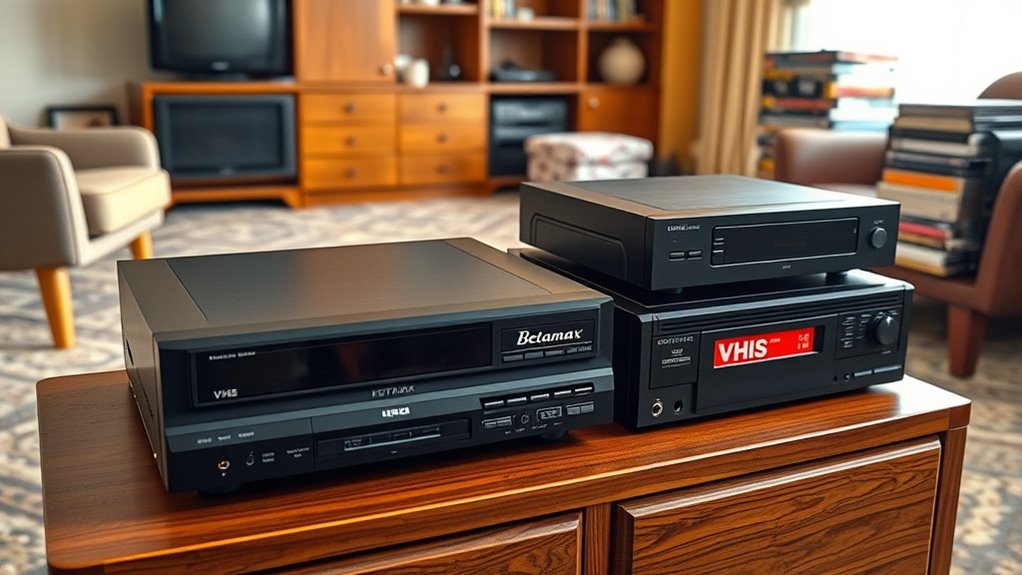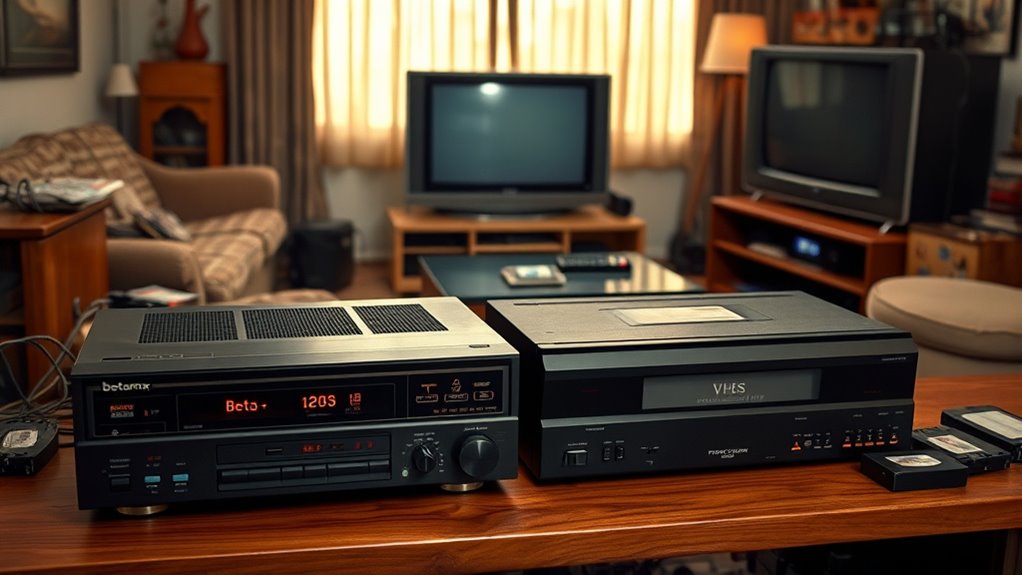The Betamax vs. VHS war reshaped your home entertainment by setting the standard for recorded video. While Betamax offered better quality and digital recording, VHS gained popularity thanks to longer playback times and widespread availability. The format battle influenced consumer choices, compatibility, and industry standards that still echo today. If you’re curious about how this rivalry shaped modern media, there’s more to uncover about their lasting impact on your living room experience.
Key Takeaways
- VHS’s longer recording time and widespread standardization led to its dominance over Betamax in the home video market.
- Betamax offered superior picture quality and digital recording but struggled with limited recording duration and incompatibility issues.
- The format war shaped future media standards, emphasizing compatibility, accessibility, and consumer convenience over technical superiority.
- VHS’s market success lowered device costs and increased tape availability, influencing the evolution of media consumption in living rooms.
- The battle’s legacy informs today’s digital media formats, highlighting the importance of standards in shaping consumer options and industry direction.

The battle between Betamax and VHS marked a pivotal moment in home entertainment history, shaping how consumers accessed and recorded video content. As a viewer, you probably experienced firsthand how this rivalry influenced which tapes you bought and which systems you used. At its core, this contest wasn’t just about technology but also about standards—specifically, format standards that determined compatibility, quality, and recording capabilities. Betamax, introduced by Sony, was praised for its superior picture quality and more precise digital recording capabilities early on. However, VHS, with its longer recording time and broader licensing agreements, gained widespread adoption. Your choice often depended on which format was more convenient and accessible, but the underlying battle was about more than just tape length or picture clarity; it was about defining standards that would set the stage for the future of home video.
When the format standards were established, VHS emerged as the dominant standard because it offered longer recording times, making it more appealing for everyday consumers who wanted to record entire movies or multiple shows without switching tapes. Betamax, although technically superior in some aspects, couldn’t match the extensive recording duration that consumers demanded. This difference in format standards created a significant barrier: if you owned a Betamax, you were limited to Betamax tapes, and vice versa. This incompatibility meant that consumers couldn’t easily switch between systems or share tapes, which further cemented VHS’s position in the market. As the technology evolved, digital recording gained prominence, shifting the focus from analog tapes to digital formats that offered even greater quality and flexibility. But back then, the format standards laid down by VHS and Betamax dictated what was possible in your living room, influencing everything from recording quality to playback compatibility. This competition also highlighted how format standards directly impacted consumer choice and market dominance.
You likely remember the frustration of trying to find a tape or player that matched your system, especially because the format standards meant not all tapes fit all players. It wasn’t just about technology but also about consumer choice, market dominance, and corporate strategy. VHS’s standardization eventually led to wider availability of tapes and recording devices, giving you more options and better prices. In the end, the rivalry shaped the future of home entertainment by establishing a clear format standard—one that prioritized longer recording times and accessibility, even if it meant sacrificing some of Betamax’s technical advantages. This competition laid the groundwork for how digital recording and format standards continue to influence media consumption today, showing the lasting impact of those early battles in your living room.
Frequently Asked Questions
How Did the Competition Impact Consumer Choice in Home Entertainment?
You notice that competition in home entertainment pushed brands to develop stronger marketing strategies, shaping your choices. As companies vied for your attention, brand loyalty became essential, influencing which products you preferred. This rivalry led to better quality, lower prices, and more options for you, empowering you with more control over your entertainment setup. Ultimately, healthy competition benefits you by fostering innovation and making home entertainment more accessible and tailored to your preferences.
What Technological Differences Set Betamax and VHS Apart?
You’ll notice Betamax and VHS differed distinctly in technological traits. Betamax boasted better picture precision, providing superior recording quality with sharper video tapes. Meanwhile, VHS offered longer recording durations, accommodating more extensive video tapes. These differences meant you could either prioritize quality or quantity, shaping your choice between the two. The technological distinctions fundamentally influenced how you experienced home entertainment, shaping the future of video tape recording and consumer preferences.
Which Company Backed Betamax and Which Backed VHS?
You should know that Sony backed Betamax, forming corporate alliances focused on quality and technology. In contrast, JVC supported VHS, adopting market strategies that emphasized longer recording times and wider licensing. These corporate alliances shaped each format’s development and distribution. Ultimately, VHS’s broader market strategy and alliances helped it dominate, while Betamax’s focus on quality limited its widespread adoption.
How Did Pricing Influence Consumer Purchasing Decisions?
Did you know that affordability factors heavily influenced consumer choices during the videotape format war? Pricing strategies played a critical role; VHS players were often priced lower than Betamax, making them more accessible. This affordability encouraged more people to buy VHS, boosting its popularity. As a result, consumers prioritized cost-effective options, which ultimately swayed the market in favor of VHS, shaping the future of home entertainment.
What Was the Long-Term Legacy of the Betamax vs. VHS Rivalry?
You see, the rivalry between Betamax and VHS shaped the technological legacy of home entertainment. It drove innovation and helped establish standards that still influence today’s technology. Culturally, it sparked a shift in how people consumed media, making movies and shows more accessible. The enduring impact is that it set the stage for future digital formats, highlighting the importance of consumer choice and technological evolution in shaping entertainment’s future.
Conclusion
As you watch the battle between Betamax and VHS unfold, remember that VHS ultimately captured 90% of the market, dominating millions of living rooms worldwide. Imagine how that tiny tape, just inches long, held the power to shape your movie nights, family memories, and entertainment choices. It’s a reminder that sometimes, the smallest innovations can leave the biggest impact, transforming your living room into a hub of endless stories and shared moments.









